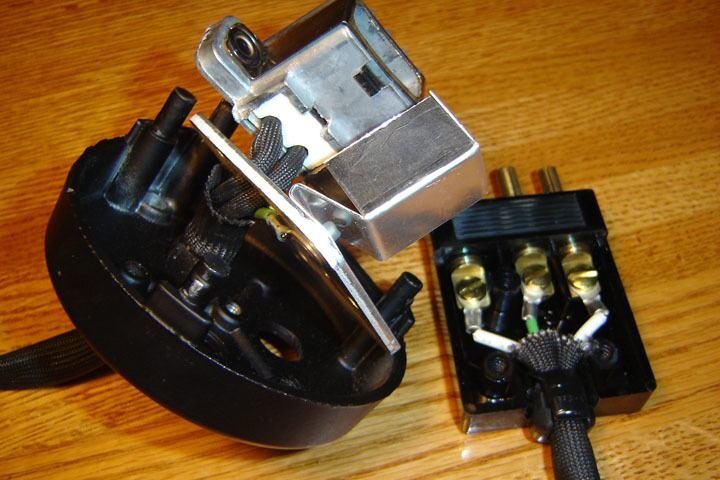It would seem that my memory is not much better than Van's thus prooving the
point of a community for advice and not relying on any one member for absolute advice.
Forgot about that wiring
cover completely, much less as the photo shows a good idea of what's up. I should have checked the
Altman website or some of the caps in my garage before advising and understanding what Van was saying.
None the less, as said,
bend the sucker out of the way than re-bend it into position when done. First check the
ground wire and it's tension on this plate. If you can move the
ground wire about or at all without serious work, it's loose and needs attention because it's not giving proper tension.
This re-tensioning of the
rivet by way of taking a punch and pounding the thing tight again or drilling it out, removing the
cover or re-using it & bolting this
ground and
cover to the plate. Make the head of screw down with
nut up by the lamp
base so as not to get in the way of a
bench focus by way of a too long screw sticking out. Put a external or internal tooth lock washer both under the head of the screw & under the
nut. Normal
nut - not nylock though a toplock
nut will also work well as long as zinc or stainless but if stainless not the same material as the screw.
In other words, zinc plated steel screws will work to some extent but given the heat, stainless steel is preferred if not brass. For the
nut the same material is preferred but if top lock type
nut, stainless steel screws and stainless steel top lock nuts don't get along together in a way that allows tension. Brass & stainless take heat better than zinc plated steel but otherwise that's details. Top lock nuts have thread deforming parts of it which sort of strip the
nut onto the screw in making it difficult to remove. This is a preferred
nut in addition to a lock washer but only to some extent for this application.
That's about re-grounding the
fixture and only if the
ground is not tight and or if it's not very feasible to pound by way of alignment pin the
rivet tight again. Should your
base plate be stripped than you would also want to
bolt lamp
base to plate.
As said, 36"
whip & sleeve it
thru the fiberglass sleeving.
In
strain relief for the
fixture, I assume you have a black plastic
Heyco type
strain relief instead of a two screw
strain relief on the
fixture. Check for brittleness on this nylon cable
grip. If it breaks, it will need to be replaced. Look at the number and letters on the small gripping insert part, that's it's part number to replace if necessary. These are standardized parts the
strain relief available
thru any electronics supply company.
http://www.heyco.co.uk/
On removing such things, a pair of
Heyco Pliers is a good investment for the theater. Makes working with them not persay easy but less difficult.
Heyco #7425K37 Pliers,
Heyco Snap-In
Cord Grip Extraction/Insertion Pliers
McMaster Carr sells them #7413k37 amongst others such as Cable Components and TechniTool. Anixter just bought out
Heyco as a company and they also have many branches around the US that can also get both the tool and
strain relief within a standard $20.00 to $30.00 price that's reasonable.
Your
crimp terminals at the
plug are also fairly standard, in this case you would need a #8 stud
ring terminal for 16-14ga
wire. Any electronics supply, above company if not McMaster Carr can supply this part. In
crimping it, you want the saddle in the seam and a proper tooth
crimp tool.
In other words, the
crimp terminal has a seam to it, this needs to be placed into the rounded part of the
crimp tool as opposed to the tooth part. Two proper
crimp tools for this would be what's commonly called a "Stakon tool." All are the same amongst the Klien #1006 Double Jaw
Crimp Tool, 16-14ga, 12-10ga and better yet for 16-14ga
wire the Klien #1005 Single Jaw
Crimp Tool, 12-10ga, Insulated
Crimp.
The #1005 will work better for a 16-14 ga.
crimp terminal. Other companies make these same tools. Concept being that a proper
crimp tool has a tooth that displaces material into the
wire as opposed to just crushes the
crimp. A proper
crimp you should very much be able to tug on - hard. For example of the proper tool McMaster Carr #7289k1 is what it looks like and everyone sells these same tools. Another good like $18.00 to $25.00 investment for the theare.
Otherwise the Klien owned Vatco company makes their #1900 tool which works well in doing the same for all three types of
crimp terminal and even flag termianls for old Union type plugs. With flag terminals otherwise you have to cut away the
wire cutter part of a Stakon tool for it to work properly in
crimping.
So there is tools, crimps & lamp
base details hopefully further of help if possible.



